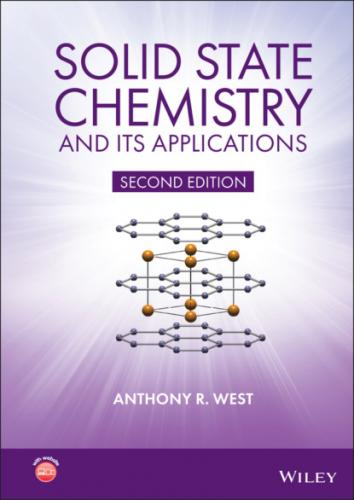In assigning fractional coordinates to the positions of atoms in a unit cell, it is customary to include in the cell those atoms whose coordinates lie between 0 and 0.999. Atoms with negative coordinates or with coordinates ≥1 then lie in adjacent unit cells. This is illustrated in Fig. 1.22(d), in which four unit cells are drawn. Let us consider the top right cell; its origin is given as the solid circle and positive directions of x, y and z are indicated by arrows. The diagram shows the coordinates of one pair of opposite, C‐face Centre positions in each of the four cells. Relative to the origin of our chosen cell, all the C-centre positions shown at the right‐hand side have x = ½ and those at the left have x = −½. All positions in the diagram have a positive y value of ½. The z values are in three sets, with values of 1, 0 and –1. In considering the contents of the top right cell, the position at ½½0 is regarded as belonging to the cell, but all other positions shown belong to neighbouring cells.
1.15 Materials that can be Described as Close Packed
1.15.1 Metals
Most metals crystallise in one of the three arrangements, ccp, hcp and bcc, the first two of which are cp structures. The distribution of structure type among the metals is irregular (Table 1.3), and no clear‐cut trends are observed. It is still not well understood why particular metals prefer one structure type to another. Calculations reveal that the lattice energies of hcp and ccp metal structures are comparable and, therefore, the structure observed in a particular case probably depends on fine details of the bonding requirements or band structures of the metal. Structural details of elements not included in Table 1.3 are given in Appendix D.
1.15.2 Alloys
Alloys are intermetallic phases or solid solutions and, as is the case for pure metals, many have cp structures. For example, Cu and Au have ccp structures, both as pure elements and when mixed to form Cu–Au alloys. At high temperatures, a complete range of solid solutions between Cu and Au forms. In these the Cu and Au atoms are distributed statistically over the lattice points of the fcc unit cell and therefore the ccp layers contain a random mixture of Cu and Au atoms. On annealing the compositions AuCu and AuCu3 at lower temperatures, the Au and Cu atoms order themselves; ccp layers still occur but the arrangement within the layers is no longer statistical. Such order–disorder phenomena occur commonly in both metallic and ionic structures.
Table 1.3 Structures, unit cell dimensions, and metallic radii of some common metals
| ccp | hcp | bcc | |||||||
|---|---|---|---|---|---|---|---|---|---|
| Metal | r/Å | a/Å | Metal | r/Å | a/Å | c/Å | Metal | r/Å | a/Å |
| Cu | 1.28 | 3.6147 | Be | 1.12 | 2.2856 | 3.5842 | Fe | 1.24 | 2.8664 |
| Ag | 1.45 | 4.0857 | Mg | 1.60 | 3.2094 | 5.2105 | Cr | 1.25 | 2.8846 |
| Au | 1.44 | 4.0783 | Zn | 1.37 | 2.6649 | 4.9468 | Mo | 1.36 | 3.1469 |
| Al | 1.43 | 4.0495 | Cd | 1.52 | 2.9788 | 5.6167 | W | 1.37 | 3.1650 |
| Ni | 1.24 | 3.5240 | Ti | 1.47 | 2.9506 | 4.6788 | Ta | 1.43 | 3.3026 |
| Pb | 1.75 | 4.9502 | Zr | 1.60 | 3.2312 | 5.1477 | Ba | 2.17 | 5.019 |
1.15.3 Ionic structures
The structures of materials such as NaCl, Al2O3, Na2O and ZnO, in which the anion is larger than the cation, are built of cp layers of anions with the cations placed in interstitial sites. Many structures are possible in which the variables are the anion stacking sequence, either hcp or ccp, and the number and type of interstitial sites occupied by cations. The cations are, however, often too large for the prescribed interstitial sites and the structure can accommodate them only by expanding the anion array. Consequently, the anion arrangement is the same as in cp, but the anions may not be in contact. O'Keeffe suggested the term eutactic for structures such as these. In the discussions that follow, use of the terms hcp and ccp for the anion arrays does not necessarily imply that the anions are in contact but rather that the structures are eutactic. A further complication, as we shall see later, is that the rigid sphere model is an oversimplification of reality since, in ionic structures, it can be difficult to specify ion sizes exactly.
It is useful at this stage to identify the criteria for an ionic structure to be regarded as close packed, since both cation and anion arrangements are involved. As with metal structures, the first criterion is that close packed anions exist with a coordination number, by other anions, of twelve. Six of these should be co‐planar, forming cp layers, as in Fig. 1.16(a). The other six form part of two cp layers to either side; the relative orientation of these two layers determines the overall stacking sequence, whether ccp or hcp.
Various departures
